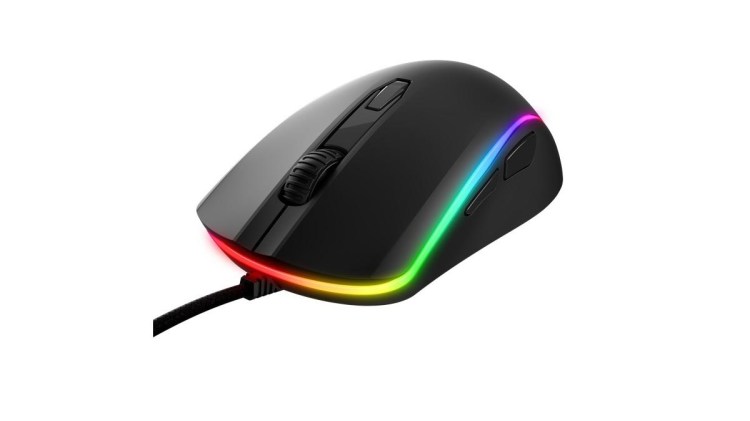HyperX has jumped into the RGB lifestyle with the Alloy Elite keyboard and its NGenuity software, and the company now wants its fans to start pairing that with the Pulsefire Surge mouse. This is the RGB LED version of its gaming mouse, which features a Pixart 3389 optical sensor, Omron switches, and onboard memory. It is available now for $70.
As with other HyperX products, it is obvious that the engineering team put a lot of thought into how gamers actually use products like this. And then they made it really nice to look at on top of that.
What you’ll like
Attractive design
The HyperX Pulsefire Surge is quite beautiful. It uses a shiny black plastic for its body that looks premium and feels great, but then HyperX accentuates tat with a wraparound programmable LED array. This thin strip goes all the way around the mouse for a full 360-degree effect, and it just looks eyepopping when you first see it.
June 5th: The AI Audit in NYC
Join us next week in NYC to engage with top executive leaders, delving into strategies for auditing AI models to ensure fairness, optimal performance, and ethical compliance across diverse organizations. Secure your attendance for this exclusive invite-only event.
If you pair it with HyperX’s relatively new NGenuity software, you can set the lights to do whatever you want. You can also add profiles so that the lights react differently depending on what you’re doing.
And since I also think the HyperX Alloy Elite RGB is wonderful and has everything you need from a mechanical keyboard, you have a viable option for syncing up the LEDs across multiple devices.
Accurate gaming performance
The Pulsefire Surge uses the same Pixart 3389 optical sensor that was in the previous HyperX mouse. This is also similar to what you’ll find in most competing high-end mice from competitors. It is capable of updating 1,000 times per second, and it is as precise as anything else on the market.
The sliding action of the Pulsefire Surge is also especially nice thanks to some oversized gliding pads on the bottom. They are smooth enough to skate across most surfaces, but HyperX of course has a selection of mouse pads that they work even better with.
HyperX transparency
When I do consumer reviews for something like a mouse, I try to always think about using it in the real world. What that means is that I try to prioritize why you’ll love or hate owning something as opposed to the buzzwords and highlight features that make you want to go out and buy something.
But I do want to give credit to HyperX for the way it sells the Pulsefire Surge. If you go out to buy a gaming mouse from a company like SteelSeries, Logitech, or Razer, you’ll get a lot of marketing speak from those companies, but it’s difficult to find out what is actually inside of those devices. HyperX, however, is refreshingly transparent. It lists the critical components that is uses right on its product page. In fact, if you search Google for the Pulsefire Surge, the snippet for the first result tells you that it has a Pixart 3389 sensor.
And nearly every gaming mouse uses a similar sensor, some have higher DPIs, but they’re all the same class of Pixart components. HyperX is the only company that will just come out and tell you that in its marketing material, and I find that commendable.
What you won’t like
Body is too short for larger hands
The Pulsefire Surge is a bit too short. I get why this makes sense for most companies — bigger hands have an easier time adjusting to smaller mice than the other way around. But I felt some cramping in the middle of my palm when trying to use the Surge for extended periods of time.
I could avoid that fatigue by relaxing and focusing on using just my fingers to hold the mouse, but that is not my natural stance. Now, I don’t think the Pulsefire Surge is too big overall. It’s probably the right width. But I prefer something longer, and I think that popular mice from companies like Logitech show that a lot of other people feel the same way.
HyperX NGenuity software needs work
You can tell that HyperX is new to this kind of software service. NGenuity is slow and unresponsive. I also think it’s a big confusing when it comes to figuring out exactly how to change some settings. I’ve also had it bug out on me when trying to update. I have faith that HyperX will get there, but I’m not gonna ask anyone else to take that for granted. As of now, NGenuity is frustrating.
Conclusion
I’m a fan of HyperX’s work. It’s easy for companies to think they can come in and make an easy buck in the high profit-margin world of PC gaming peripherals, but HyperX always makes a real effort to build a legitimately impressive product. And that shines through once again with the Pulsefire Surge.
If you aren’t someone who needs to fiddle in the software for your mouse a lot, the Surge has no downsides besides its length. And you may not prefer an extra-long mouse the way I do. So I recommend the Pulsefire Surge with the assumption that you can get your hands on it for yourself first or you buy it somewhere with a friendly exchange policy.
The Pulsefire Surge is available now for $70. HyperX provided a sample unit for the purpose of this review.


